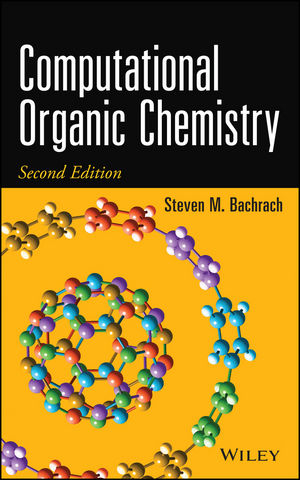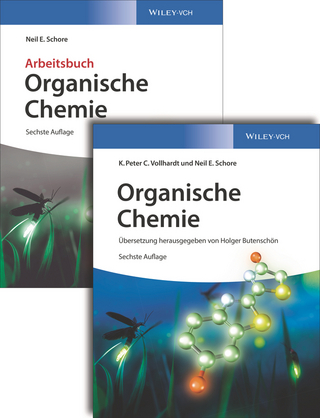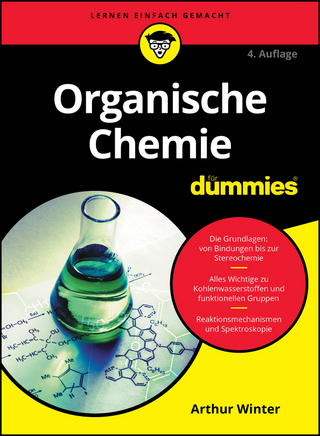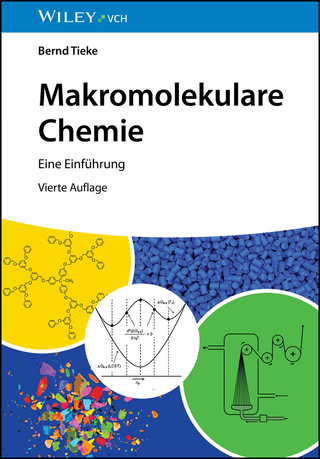
Computational Organic Chemistry
John Wiley & Sons Inc (Verlag)
978-1-118-29192-4 (ISBN)
- Titel z.Zt. nicht lieferbar
- Versandkostenfrei innerhalb Deutschlands
- Auch auf Rechnung
- Verfügbarkeit in der Filiale vor Ort prüfen
- Artikel merken
The Second Edition demonstrates how computational chemistry continues to shed new light on organic chemistry
The Second Edition of author Steven Bachrach’s highly acclaimed Computational Organic Chemistry reflects the tremendous advances in computational methods since the publication of the First Edition, explaining how these advances have shaped our current understanding of organic chemistry. Readers familiar with the First Edition will discover new and revised material in all chapters, including new case studies and examples. There’s also a new chapter dedicated to computational enzymology that demonstrates how principles of quantum mechanics applied to organic reactions can be extended to biological systems.
Computational Organic Chemistry covers a broad range of problems and challenges in organic chemistry where computational chemistry has played a significant role in developing new theories or where it has provided additional evidence to support experimentally derived insights. Readers do not have to be experts in quantum mechanics. The first chapter of the book introduces all of the major theoretical concepts and definitions of quantum mechanics followed by a chapter dedicated to computed spectral properties and structure identification. Next, the book covers:
Fundamentals of organic chemistry
Pericyclic reactions
Diradicals and carbenes
Organic reactions of anions
Solution-phase organic chemistry
Organic reaction dynamics
The final chapter offers new computational approaches to understand enzymes. The book features interviews with preeminent computational chemists, underscoring the role of collaboration in developing new science. Three of these interviews are new to this edition.
Readers interested in exploring individual topics in greater depth should turn to the book’s ancillary website www.comporgchem.com, which offers updates and supporting information. Plus, every cited article that is available in electronic form is listed with a link to the article.
STEVEN M. BACHRACH is the Dr. D. R. Semmes Distinguished Professor of Chemistry at Trinity University. Dr. Bachrach has published some 125 articles. With the support of the National Science Foundation and the Welch Foundation, he researches computational approaches to build our understanding of nucleophilic substitution reactions and the role of solvents.
Preface xv
Acknowledgments xxi
1. Quantum Mechanics for Organic Chemistry 1
1.1 Approximations to the Schrödinger Equation—The Hartree–Fock Method 2
1.1.1 Nonrelativistic Mechanics 2
1.1.2 The Born–Oppenheimer Approximation 3
1.1.3 The One-Electron Wavefunction and the Hartree–Fock Method 3
1.1.4 Linear Combination of Atomic Orbitals (LCAO) Approximation 4
1.1.5 Hartree–Fock–Roothaan Procedure 5
1.1.6 Restricted Versus Unrestricted Wavefunctions 7
1.1.7 The Variational Principle 7
1.1.8 Basis Sets 8
1.1.8.1 Basis Set Superposition Error 12
1.2 Electron Correlation—Post-Hartree–Fock Methods 13
1.2.1 Configuration Interaction (CI) 14
1.2.2 Size Consistency 16
1.2.3 Perturbation Theory 16
1.2.4 Coupled-Cluster Theory 17
1.2.5 Multiconfiguration SCF (MCSCF) Theory and Complete Active Space SCF (CASSCF) Theory 18
1.2.6 Composite Energy Methods 20
1.3 Density Functional Theory (DFT) 22
1.3.1 The Exchange-Correlation Functionals: Climbing Jacob’s Ladder 24
1.3.1.1 Double Hybrid Functionals 26
1.3.2 Dispersion-Corrected DFT 26
1.3.3 Functional Selection 28
1.4 Computational Approaches to Solvation 28
1.4.1 Microsolvation 28
1.4.2 Implicit Solvent Models 29
1.4.3 Hybrid Solvation Models 34
1.5 Hybrid QM/MM Methods 35
1.5.1 Molecular Mechanics 36
1.5.2 QM/MM Theory 38
1.5.3 ONIOM 39
1.6 Potential Energy Surfaces 40
1.6.1 Geometry Optimization 42
1.7 Population Analysis 45
1.7.1 Orbital-Based Population Methods 46
1.7.2 Topological Electron Density Analysis 47
1.8 Interview: Stefan Grimme 48
References 51
2. Computed Spectral Properties and Structure Identification 61
2.1 Computed Bond Lengths and Angles 61
2.2 IR Spectroscopy 62
2.3 Nuclear Magnetic Resonance 66
2.3.1 General Considerations 68
2.3.2 Scaling Chemical Shift Values 69
2.3.3 Customized Density Functionals and Basis Sets 71
2.3.4 Methods for Structure Prediction 73
2.3.5 Statistical Approaches to Computed Chemical Shifts 74
2.3.6 Computed Coupling Constants 76
2.3.7 Case Studies 77
2.3.7.1 Hexacyclinol 77
2.3.7.2 Maitotoxin 79
2.3.7.3 Vannusal B 80
2.3.7.4 Conicasterol F 81
2.3.7.5 1-Adamantyl Cation 81
2.4 Optical Rotation, Optical Rotatory Dispersion, Electronic Circular Dichroism, and Vibrational Circular Dichroism 82
2.4.1 Case Studies 85
2.4.1.1 Solvent Effect 85
2.4.1.2 Chiral Solvent Imprinting 86
2.4.1.3 Plumericin and Prismatomerin 87
2.4.1.4 2,3-Hexadiene 88
2.4.1.5 Multilayered Paracyclophane 89
2.4.1.6 Optical Activity of an Octaphyrin 90
2.5 Interview: Jonathan Goodman 90
References 93
3. Fundamentals of Organic Chemistry 99
3.1 Bond Dissociation Enthalpy 99
3.1.1 Case Study of BDE: Trends in the R–X BDE 102
3.2 Acidity 104
3.2.1 Case Studies of Acidity 107
3.2.1.1 Carbon Acidity of Strained Hydrocarbons 107
3.2.1.2 Origin of the Acidity of Carboxylic Acids 113
3.2.1.3 Acidity of the Amino Acids 116
3.3 Isomerism and Problems With DFT 119
3.3.1 Conformational Isomerism 119
3.3.2 Conformations of Amino Acids 121
3.3.3 Alkane Isomerism and DFT Errors 123
3.3.3.1 Chemical Consequences of Dispersion 131
3.4 Ring Strain Energy 132
3.4.1 RSE of Cyclopropane (28) and Cylcobutane (29) 138
3.5 Aromaticity 144
3.5.1 Aromatic Stabilization Energy (ASE) 145
3.5.2 Nucleus-Independent Chemical Shift (NICS) 150
3.5.3 Case Studies of Aromatic Compounds 155
3.5.3.1 [n]Annulenes 155
3.5.3.2 The Mills–Nixon Effect 166
3.5.3.3 Aromaticity Versus Strain 171
3.5.4 π–π Stacking 173
3.6 Interview: Professor Paul Von RaguéSchleyer 177
References 180
4. Pericyclic Reactions 197
4.1 The Diels–Alder Reaction 198
4.1.1 The Concerted Reaction of 1,3-Butadiene with Ethylene 199
4.1.2 The Nonconcerted Reaction of 1,3-Butadiene with Ethylene 207
4.1.3 Kinetic Isotope Effects and the Nature of the Diels–Alder Transition State 209
4.1.4 Transition State Distortion Energy 214
4.2 The Cope Rearrangement 215
4.2.1 Theoretical Considerations 217
4.2.2 Computational Results 219
4.2.3 Chameleons and Centaurs 227
4.3 The Bergman Cyclization 233
4.3.1 Theoretical Considerations 237
4.3.2 Activation and Reaction Energies of the Parent Bergman Cyclization 239
4.3.3 The cd Criteria and Cyclic Enediynes 244
4.3.4 Myers–Saito and Schmittel Cyclization 249
4.4 Bispericyclic Reactions 256
4.5 Pseudopericyclic Reactions 260
4.6 Torquoselectivity 267
4.7 Interview: Professor Weston Thatcher Borden 278
References 282
5. Diradicals and Carbenes 297
5.1 Methylene 298
5.1.1 Theoretical Considerations of Methylene 298
5.1.2 The H–C–H Angle in Triplet Methylene 299
5.1.3 The Methylene and Dichloromethylene Singlet–Triplet Energy Gap 300
5.2 Phenylnitrene and Phenylcarbene 304
5.2.1 The Low Lying States of Phenylnitrene and Phenylcarbene 305
5.2.2 Ring Expansion of Phenylnitrene and Phenylcarbene 312
5.2.3 Substituent Effects on the Rearrangement of Phenylnitrene 317
5.3 Tetramethyleneethane 324
5.3.1 Theoretical Considerations of Tetramethyleneethane 326
5.3.2 Is TME a Ground-State Singlet or Triplet? 326
5.4 Oxyallyl Diradical 330
5.5 Benzynes 333
5.5.1 Theoretical Considerations of Benzyne 333
5.5.2 Relative Energies of the Benzynes 336
5.5.3 Structure of m-Benzyne 341
5.5.4 The Singlet–Triplet Gap and Reactivity of the Benzynes 345
5.6 Tunneling of Carbenes 349
5.6.1 Tunneling control 353
5.7 Interview: Professor Henry “Fritz” Schaefer 355
5.8 Interview: Professor Peter R. Schreiner 357
References 360
6. Organic Reactions of Anions 373
6.1 Substitution Reactions 373
6.1.1 The Gas Phase SN2 Reaction 374
6.1.2 Effects of Solvent on SN2 Reactions 385
6.2 Asymmetric Induction Via 1,2-Addition to Carbonyl Compounds 391
6.3 Asymmetric Organocatalysis of Aldol Reactions 404
6.3.1 Mechanism of Amine-Catalyzed Intermolecular Aldol Reactions 409
6.3.2 Mechanism of Proline-Catalyzed Intramolecular Aldol Reactions 417
6.3.3 Comparison with the Mannich Reaction 421
6.3.4 Catalysis of the Aldol Reaction in Water 426
6.3.5 Another Organocatalysis Example—The Claisen Rearrangement 429
6.4 Interview: Professor Kendall N. Houk 432
References 435
7. Solution-Phase Organic Chemistry 445
7.1 Aqueous Diels–Alder Reactions 446
7.2 Glucose 452
7.2.1 Models Compounds: Ethylene Glycol and Glycerol 453
7.2.1.1 Ethylene Glycol 453
7.2.1.2 Glycerol 458
7.2.2 Solvation Studies of Glucose 460
7.3 Nucleic Acids 468
7.3.1 Nucleic Acid Bases 469
7.3.1.1 Cytosine 469
7.3.1.2 Guanine 473
7.3.1.3 Adenine 475
7.3.1.4 Uracil and Thymine 477
7.3.2 Base Pairs 479
7.4 Amino Acids 489
7.5 Interview: Professor Christopher J. Cramer 492
References 496
8. Organic Reaction Dynamics 505
8.1 A Brief Introduction To Molecular Dynamics Trajectory Computations 508
8.1.1 Integrating the Equations of Motion 508
8.1.2 Selecting the PES 510
8.1.3 Initial Conditions 511
8.2 Statistical Kinetic Theories 512
8.3 Examples of Organic Reactions With Non-Statistical Dynamics 514
8.3.1 [1,3]-Sigmatropic Rearrangement of Bicyclo[3.2.0]hex-2-ene 514
8.3.2 Life in the Caldera: Concerted versus Diradical Mechanisms 518
8.3.2.1 Rearrangement of Vinylcyclopropane to Cyclopentene 520
8.3.2.2 Bicyclo[3.1.0]hex-2-ene 20 524
8.3.2.3 Cyclopropane Stereomutation 526
8.3.3 Entrance into Intermediates from Above 530
8.3.3.1 Deazetization of 2,3-Diazabicyclo[2.2.1]hept-2-ene 31 530
8.3.4 Avoiding Local Minima 533
8.3.4.1 Methyl Loss from Acetone Radical Cation 533
8.3.4.2 Cope Rearrangement of 1,2,6-Heptatriene 534
8.3.4.3 The SN2 Reaction: HO− + CH3F 536
8.3.4.4 Reaction of Fluoride with Methyl Hydroperoxide 538
8.3.5 Bifurcating Surfaces: One TS, Two Products 539
8.3.5.1 C2–C6 Enyne Allene Cyclization 540
8.3.5.2 Cycloadditions Involving Ketenes 543
8.3.5.3 Diels–Alder Reactions: Steps toward Predicting Dynamic Effects on Bifurcating Surfaces 547
8.3.6 Stepwise Reaction on a Concerted Surface 550
8.3.6.1 Rearrangement of Protonated Pinacolyl Alcohol 550
8.3.7 Roaming Mechanism 551
8.3.8 A Roundabout SN2 reaction 553
8.3.9 Hydroboration: Dynamical or Statistical? 554
8.3.10 A Look at the Wolff Rearrangement 555
8.4 Conclusions 557
8.5 Interview: Professor Daniel Singleton 558
References 561
9. Computational Approaches to Understanding Enzymes 569
9.1 Models for Enzymatic Activity 569
9.2 Strategy for Computational Enzymology 573
9.2.1 High Level QM/MM Computations of Enzymes 576
9.2.2 Chorismate Mutase 578
9.2.3 Catechol-O-Methyltransferase (COMT) 582
9.3 De Novo Design of Enzymes 586
References 592
Index 599
| Erscheint lt. Verlag | 9.5.2014 |
|---|---|
| Verlagsort | New York |
| Sprache | englisch |
| Maße | 163 x 236 mm |
| Gewicht | 998 g |
| Themenwelt | Naturwissenschaften ► Chemie ► Organische Chemie |
| ISBN-10 | 1-118-29192-1 / 1118291921 |
| ISBN-13 | 978-1-118-29192-4 / 9781118291924 |
| Zustand | Neuware |
| Informationen gemäß Produktsicherheitsverordnung (GPSR) | |
| Haben Sie eine Frage zum Produkt? |
aus dem Bereich


